(Cross posted at Living in the O.)
Next Thursday, transit advocates have what will probably be our best chance to change the Oakland Airport Connector (OAC) from an incredibly wasteful rail connection with $6 fares into a much cheaper rapid bus connection that could potentially be free for riders. At the last meeting, 11 of us spoke out against the current OAC project and in favor of a bus solution, and we made a huge difference, with the BART Board nearly unanimously agreeing to postpone the vote so more studies could be done on a rapid bus option. Imagine what a difference 50 or 100 of us could make next week.
Please join us at the BART Board meeting to reclaim transit funding for BART, AC Transit, and other Bay Area transit agencies and to secure a project that make sense for the region:
What: BART Board Meeting on the Oakland Airport Connector
When: Thursday, May 14th @ 9am (TransForm recommends showing up by 8:30 if you’d like to get a seat in the Board room; if not, there is an overflow room.)
Where: Kaiser Center – Third Floor, 344 20th Street in Oakland
If you cannot make it to the meeting, but want to tell the BART directors how you feel, please send an email via TransForm’s action page. You can find a pre-written message there, but I encourage you to take the time to personalize the email, as non-form letters are always more effective.
OK, now that you’re on board to take action, onto the fun stuff. BART has put transit advocates in a similar situation to the one we just had in Oakland, when redevelopment staff refused to look into alternatives for the surface parking lot so advocates (well, mostly me and dto510) had to do research into displaying public art. Though the BART Board directed staff to look into a bus rapid transit (BRT) alternative, we weren’t convinced they would so TransForm went ahead and did the research themselves and produced a phenomenal report in two weeks about a bus alternative that they’re calling RapidBART. Pictured below is what RapidBART would look like, exiting the Coliseum BART station.
So what makes RapidBART so much better than the current OAC proposal? Via the report, it would:
- Cost dramatically less (possibly as much 90% less to build!).
- Use some of the existing funds dedicated to building the Oakland Airport Connector to make service free to riders in perpetuity.
- Have similar travel times to the proposed Connector.
- Allow intermediate stops to better serve the East Oakland community.
- Stop in front of any future terminals at almost no cost.
- Keep BART from incurring any debt or risk.
- Result in more, sustainable long-term jobs.
Sounds pretty damn good to me, but I wouldn’t blame you if you thought this sounded too good to be true. Fortunately, John Knox White and Stuart Cohen of TransForm did a thorough job researching the numbers and logistics and created a solid plan. Below are some questions you might have that they answer in the report.
How will RapidBART run more quickly than the current AirBART bus?
If you’ve taken AirBART, then you know that the main delay is often loading of passengers. I’ve seen loading take up to 15 minutes as everyone squeezes through the front door, fumbles for the correct change, and moves slowly with luggage. RapidBART would have multiple doors for loading and unloading, just like BART does. Better yet, it will be free, which means you won’t have to wait while someone tries to find change for a $20 bill.
The other delays on AirBART are caused by getting stopped at traffic signals and getting stuck in car traffic. Signals can easily be dealt with using signal prioritization, which can keep a light green until RapidBART passes through. Navigating past traffic can be accomplished by using right hand queue jump lanes. Often, traffic gets backed up at intersections:
A queue jump lane would allow RapidBART to enter the right turn lane, crossing the intersection before car traffic can move, and then merging back into the mixed flow lane:
Queue jump lanes would be placed at most intersections throughout the route. Then, when RapidBART reached Airport Drive, it would enter its own dedicated bus lane.
How much cheaper would RapidBART be to build, compared to OAC?
A lot. OAC would cost $550 million while RapidBART is projected to cost $45-$60 million. That’s a savings of $500 million!
What could be done with the savings?
The $70 million of stimulus funds would be reallocated back to the transit agencies, including BART, which would receive $15 million that could be used to halt some of their service cuts and/or fare increases. (AC Transit, Muni, and other agencies could do the same with their shares.)
Other funds could be used to subsidize fares so that the system would be free:
In particular, TransForm is recommending that BART request the Metropolitan Transportation Commission to shift the $65 million of Regional Measure 2 funds designated for the Oakland Airport Connector into an annual operating revenue source.
If additional funds are needed then some of OAC’s Regional Measure 1 funds could be used. Another source could be the Port of Oakland’s proposed contribution, which could be used as an endowment in an interest-bearing account that throws off an annual operating dividend. (The Port’s contribution could be reduced from the $44 million currently slated).
Another idea I’ve heard that isn’t expressed in the TransForm report is to use some of the savings to help fund the construction of a transit village around the Coliseum BART station. Oakland City Councilmember Larry Reid and BART Director Carol Ward-Allen are both strongly committed to building a transit village there so hopefully they’ll see that the savings from RapidBART could greatly benefit this project.
Where would RapidBART stop?
The first stop would be at the Coliseum BART station, in an enclosed area underneath the BART platform. It would then head down Hegenberger and stop somewhere in between BART and the airport. TransForm proposes stopping at Pardee and Hegenberger, but the great thing about RapidBART is that it’s easily adjustable. As business grows in the area, a RapidBART station could be moved for a small cost, or another intermediary stop could be built.
At the airport, RapidBART would stop at both terminals, where the AirBART currently stops. The total walk time to either of the terminals would be 2 minutes. The rail OAC, on the other hand, would stop in between the terminals and passengers would have to walk down to street level and across parking lots. TransForm estimates that this would take 3 minutes. However, if Oakland Airport were to build a third terminal (which has been discussed), it would take 7-8 minutes to walk to this new terminal from OAC. It would be easy and cheap to build a third RapidBART station so the time it would take to walk to a third terminal from RapidBART would also be just 2 minutes.
What would the RapidBART schedule be?
The RapidBART would operate the same hours as BART and would have 4-10 minute headways depending on the time of day.
But isn’t rail so much more comfortable than buses?
It doesn’t have to be that way. Check out these pictures of the Eindhoven Airport BRT connector. To me, they look even more comfortable than BART.
Previous posts on the Oakland Airport Connector:

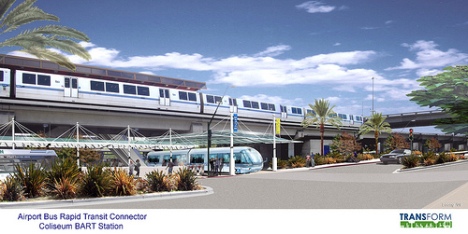
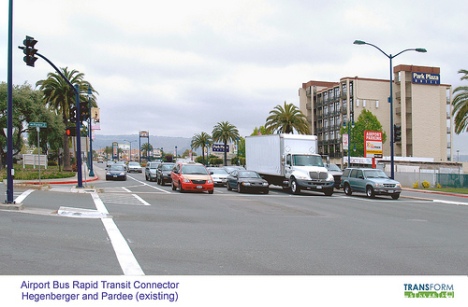
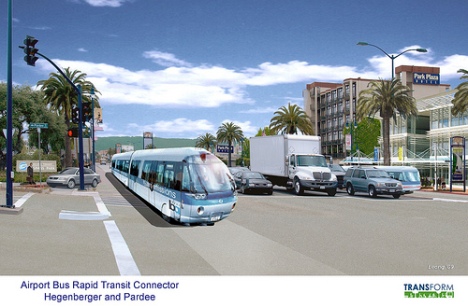
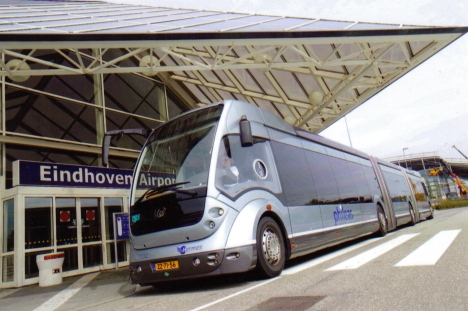
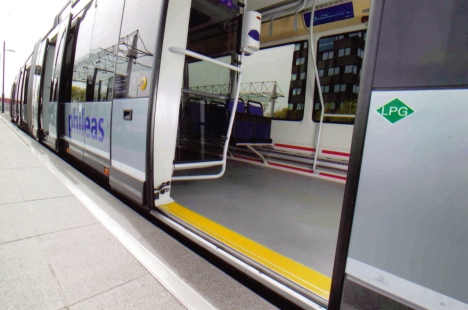
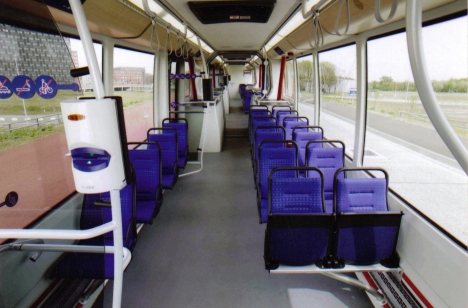
You must be logged in to post a comment.